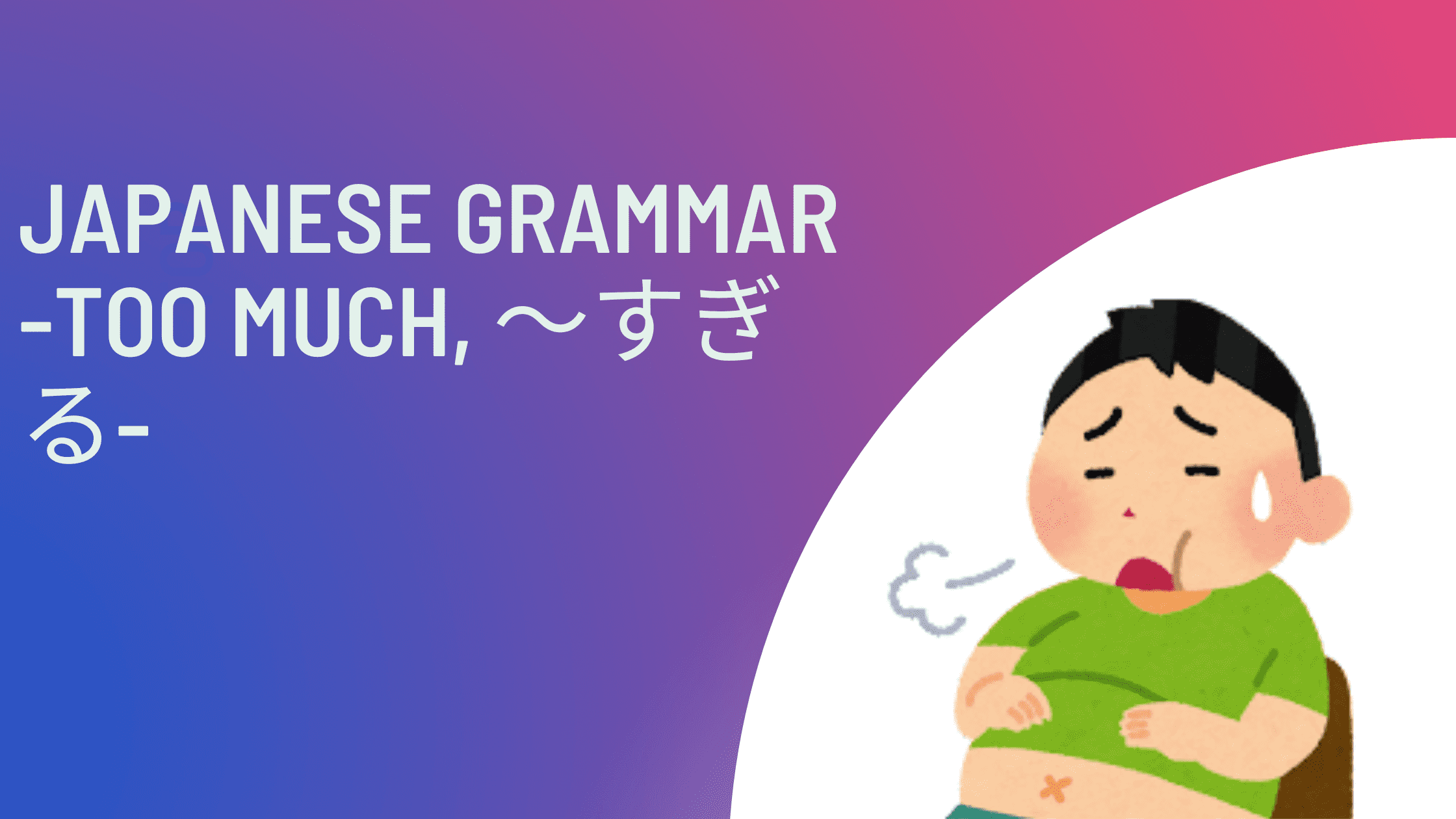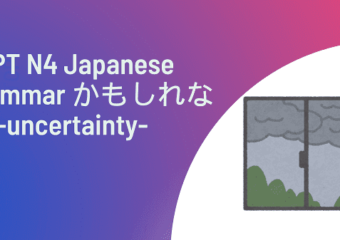When something exceeds the standard and it causes a problem, how can you explain the situation?
In this case, you can use ~すぎる.
In this article, I’ll teach you what ~すぎる is and how to use it.
*Are you looking for a place to practice Japanese?
Youtonihongo is for you.
You may receive one free 30-minute trial lesson.

The free trial class online
We offer online classes and in person classes
What is ~すぎる?
We use ~すぎる to express too much, especially something that exceeds the standard so much it causes a problem.
Conjugation
Vます+すぎる。
(れい)たべます→たべ→たべすぎる
Adjい+すぎる。
よい(いい)→よすぎる
(れい)大きい→大き→大きすぎる
ナAdj+すぎる。
(れい)しずかすぎる
Nounが+すぎる。(only some nouns)
Negative form:なさすぎる
(れい)
たべなさすぎる。おもしろくなさすぎる。
If you don’t know what ない form is, please read this article.
LEARNING NEGATIVE SENTENCES IN JAPANESE
Let’s see some examples.
you went to an all-you-can-eat restaurant.
You ate a lot and you got a stomachache.
In other words, the amount you ate exceeds the standard (In this case, how much your stomach can hold) and you are now suffering from a stomachache.
English:I have a stomachache because I ate too much.
Let’s see another example.
The soup is too hot for you to eat.
In other words, the temperature of the soup exceeds the standard of what you can have and it causes a problem because you can’t eat.
You can say…
English:This soup is too hot to eat.
Let’s move on to another example.
Someone doesn’t know common sense at all.
In other words, the level of what he doesn’t know exceeds standard that you expect.
You can say…
English:He doesn’t know common sense at all.
In my opinion, this sentence focuses on your feeling that you are very surprised because he doesn’t have any common sense.
If you say “かれは じょうしきを ぜんぜん しらない”, it just focuses on the fact, not on your opinion.
Let’s move on to noun sentences.
Some nouns can connect to がすぎる such as いたずらがすぎる or わがままがすぎる.
However, the number of nouns which can connect to すぎる are very limited
If a child gets into mischief and it is so dangerous, you can say…
English:You’re causing too much mischeif!
Textbooks don’t teach noun + すぎる, but according to Tokyo Keizai University, if the noun expresses the degree such as 金もち (Rich), you can use noun + すぎる.
Current transition
As we have discussed, originally, すぎる is…
1.something that exceeds the standard and it causes a problem.
2.rarely used with nouns.
However, recently, young people use すぎる without this standard.
For example, there is an idol who is called “てんしすぎるアイドル”
(Fyi, this photo is called “てんしすぎるアイドル”)
It’s hard to translate, but maybe, she is a really cute idol like an angel?
Obviously, this sentence is positive and this noun (angel) doesn’t relate to the degree.
Nevertheless, young people use this phrase commonly.
You know, languages have been changing, so there is a possibility that this grammatical rule would change in 20 years as well.
conclusion

We use ~すぎる to express too much, especially something exceeds the standard and it causes a problem.
Conjugation
Vます+すぎる。
(れい)たべます→たべ→たべすぎる
Adjい+すぎる。
よい(いい)→よすぎる
(れい)大きい→大き→大きすぎる
ナAdj+すぎる。
(れい)しずかすぎる
Nounが+すぎる。(only some nouns)
Negative form:なさすぎる
Excercise
1.先生のしごとは(いそがしいです)すぎる。
2.きのう(のみます)すぎて、あたまがいたいです。
3.テレビが(うるさいです)すぎてねむれません。しずかにしてください。
4.かんじをおぼえるのは(むずかしいです)すぎる。
5.かれは(しずかです)すぎて、何をかんがえているのかわからない。
Answer
1.先生のしごとは(いそがし)すぎる。
2.きのう(のみ)すぎて、あたまがいたいです。
3.テレビが(うるさ)すぎてねむれません。しずかにしてください。
4.かんじをおぼえるのは(むずかし)すぎる。
5.かれは(しずか)すぎて、何をかんがえているのかわからない。
If you’d like to learn more Japanese, please feel free to contact me.
I teach Japanese in-person or online.
You can also learn Japanese on my Instagram page.

The free trial class online
We offer online classes and in person classes



